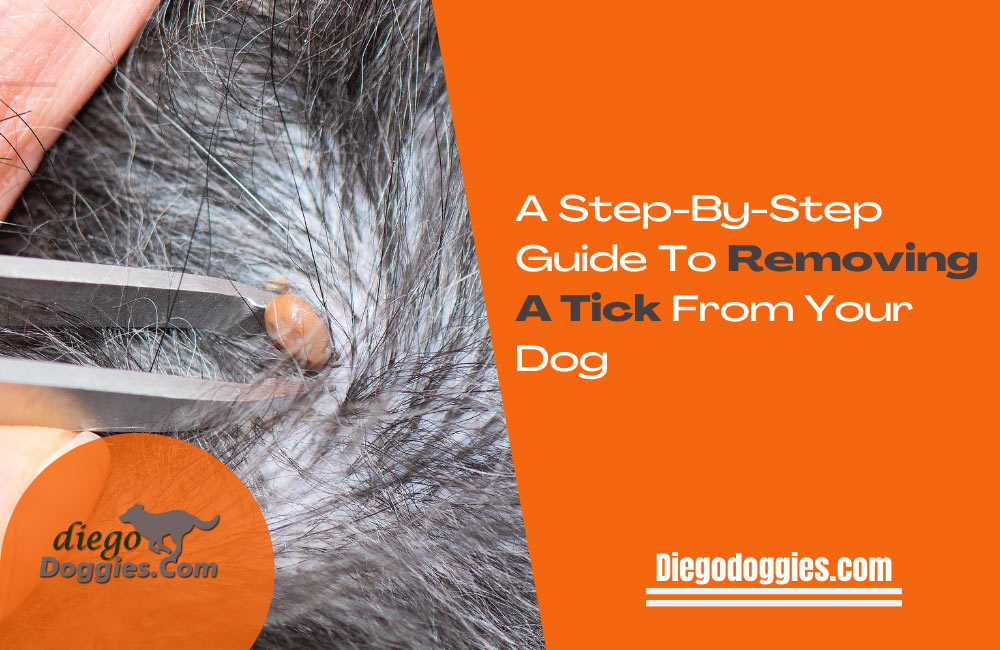Ticks are small, parasitic insects that can attach themselves to the skin of dogs and other animals. Ticks feed on the blood of their host and can transmit diseases between animals and humans. It’s therefore important to remove ticks from dogs as soon as possible.
In this blog post, we’ll show you how to spot a tick on your dog and provide a step-by-step guide for safely removing it. We’ll also share some tips for preventing ticks on your dog in the future.
1. Why It’s Important To Remove Ticks From Dogs
Ticks are small, parasitic creatures that can attach themselves to the skin of dogs (and humans). Ticks feed on blood and can cause a number of problems for their hosts, including anemia, skin irritation, and in some cases, Lyme disease. Lyme disease is a serious condition that can cause a range of symptoms, including joint pain, fever, and fatigue.
In severe cases, it can lead to heart problems or even death. For this reason, it’s important to remove ticks from dogs as soon as they’re discovered. The best way to remove a tick is to use a pair of tweezers or tick removal tool to gently pull it straight out. Once the tick has been removed, disinfect the area with rubbing alcohol.
2. How To Spot A Tick On Your Dog
Ticks can be a big problem for dogs, and they’re not always easy to spot. They’re small, dark, and often hide in hard-to-reach places like the ears or between the toes. If you suspect that your dog has a tick, the best thing to do is to conduct a thorough inspection.
Start by running your hands along your dog’s body, paying particular attention to the areas where ticks are most likely to hide. Next, use a comb or brush to part your dog’s fur so that you can get a better look at their skin.
If you see any bumps or dark spots, carefully remove the hair around the area so that you can get a better look. Keep an eye out for anything that looks like a bump.
3. The Best Way To Remove A Tick From Your Dog
If you find a tick on your dog, there’s no need to panic. While ticks can transmit diseases, with a little care and attention, you can remove the tick safely and effectively. The first thing you’ll need to do is purchase a tick remover from your local pet store.
These devices are specifically designed to remove ticks, and they make the process much simpler. Once you have your tick remover, gently grasp the tick as close to the dog’s skin as possible. Slowly and steadily twist the remover until the tick releases its grip.
Be careful not to crush the tick, as this could cause disease-carrying fluids to be released into your dog’s bloodstream. With the tick removed, properly dispose of it and clean the area
4. What To Do After You’ve Removed The Tick From Your Dog
After you remove the tick from your dog, there are a few things you should do to make sure your pet stays healthy. First, clean the area around the bite with rubbing alcohol. Then, apply a topical antiseptic to the wound.
You should also keep an eye on the area for any signs of infection, such as redness, swelling, or discharge. If you notice any of these symptoms, it’s important to take your dog to the vet right away. Finally, it’s a good idea to check your dog for ticks on a regular basis, especially if they spend a lot of time outdoors. By taking these simple steps, you can help keep your dog healthy and Tick-free!
5. Tips For Preventing Ticks On Your Dog In The Future
Springtime means warmer weather and more time outdoors, but it also brings with it an increased risk of ticks. These small pests can attach themselves to your dog while they’re out exploring, and if they’re not removed quickly, they can cause serious health problems. Luckily, there are a few simple steps you can take to help prevent ticks on your dog in the future.
First, make sure to check them for ticks after every walk or hike. Pay close attention to their legs, belly, and neck, as these are the most common places for ticks to attach.
If you find any ticks, remove them immediately using a pair of fine-tipped tweezers. Second, talk to your veterinarian about tick prevention products such as collars or spot
Call To Action
If you live in a tick-prone area or intend to visit one it is wise to purchase a flea and tick collar as well as a tick removal tool. If you have an infestation of fleas or ticks having a household spray to counteract them is a wise idea. Always, if in doubt always consult your vet.
- Alga Norte Dog Park with Training Obstacles & Nice Off-Leash Areas
- Coronado Dog Beach near San Diego Offers Great Point Loma Views
- Del Mar Dog Beach with Spectacular Cliff Views
- Dusty Rhodes Dog Park in San Diego near Ocean Beach
- Fiesta Island Dog Beach Off-Leash Dog Park at Mission Bay
- Grape Street Dog Park in Balboa Park Brings Nature to the City
- Morley Field Off-Leash Dog Park in Balboa Park – Amazing Canyon Views
- Nate’s Point Off-Leash Dog Park at Balboa Park
- Ocean Beach Off-Leash Dog Beach in San Diego, CA
- Rancho Bernardo Off-Leash Dog Park in San Diego, CA
- San Diego Dog Park Safety Tips, Training, and Dog Accessories
- What You Should Do To Become a Responsible Dog Owner
- 7 Benefits of Dog Grooming and Exercising in San Diego
- Dog Grooming – Tips And Tools
- How To Clean A Dog’s Clothes, Sweaters, Bedding & Collars
- 10 Best Park Accessories for Dog Owners
- Is Your Dog Barking Excessively And Annoying Your Neighbours?
- Dog Grooming Take- Diego Doggies
- Restrain a Dog for Grooming: The Safe and Easy Way
- Start a Dog Grooming Business
- Adopt a Dog in San Diego: Everything You Need to Know
- Dog Training Cost? A Comprehensive Guide
- Right Dog Raincoat: The Ultimate Guide


6 thoughts on “A Step-By-Step Guide To Removing A Tick From Your Dog”